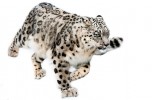Il superpredatore delle montagne asiatiche minacciato dall’uomo e dai cambiamenti climatici: a oggi si stimano meno di 7 mila esemplari
Il leopardo delle nevi è un felino di grossa taglia che vive sulle catene montuose dell’Asia centrale ed è presente in vari stati tra cui il Pakistan, la Cina, il Bhutan, il Nepal e la Mongolia. Vive generalmente tra i 3000 e i 4500 metri di altitudine, in un ambiente secco, roccioso, ricco di arbusti e praterie.
Un piccolo superpredatore d'alta quota
Il leopardo delle nevi è coperto da una folta pelliccia grigiastra, che gli è valsa il soprannome di “fantasma delle nevi”; lievemente tinto di crema, coperto di macchie scure e rosette irregolari, il fitto e caldo manto gli permette di sopportare temperature rigidissime e di affrontare anche gli inverni più freddi. Le ampie piante delle zampe fungono da racchettoni, così che non sprofondi nella neve; le fosse nasali - insolitamente grandi - gli consentono di respirare tranquillamente l’aria gelida e rarefatta delle alte quote. In gran parte del suo habitat, il leopardo delle nevi è il predatore più grande, per cui si posiziona in cima alla catena alimentare; svolge quindi un ruolo di superpredatore, regolando le popolazioni di cacciatori minori, quali sciacalli, volpi, gatti selvatici e linci.
Eppure, rispetto ai felini suoi simili, il leopardo delle nevi è uno dei più piccoli; pesa infatti tra i 27 e i 55 chili e la lunghezza del corpo è compresa tra i 75 e 130 centimetri. La coda è lunga circa un metro, praticamente quanto il corpo, e gli permette non solo di mantenere l’equilibrio durante la corsa, ma anche di ripararsi il muso dal freddo, avvolta su se stessa e usata come sciarpa. Caccia abitualmente di notte o all’alba e le sue prede preferite sono pecore selvatiche e capre, ma anche cervi, giovani yak, asini selvatici e bestiame allo stato brado; in realtà, come molti felini, è un predatore opportunistico, per cui si nutre di ogni genere di carne che riesce a trovare.
È in grado di abbattere animali tre o quattro volte più grandi di lui, anche se di solito si limita a prede più piccole. La tecnica di caccia consiste nel mimetizzarsi nella neve e attaccare di sorpresa le vittime, con balzi prodigiosi che raggiungono i quattro metri di altezza. Un essere spaventoso e assai temibile, dunque, per la fauna delle montagne asiatiche. Contrariamente a quanto ci si aspetterebbe, però, il fantasma delle nevi non è in grado di ruggire; i suoi vocalizzi sono più simili a quelli di un gatto che di una tigre: per via di alcuni aspetti morfologici della laringe, non emette niente più che sibili, fusa e miagolii.
Braccato dall'uomo
La specie è stata scoperta solo all’inizio del secolo scorso e se ne sa ancora troppo poco, per via della sua elusività e dell’ostilità dell’ambiente in cui vive: due elementi che hanno reso ardua anche la conta degli esemplari. A oggi si stima che si siano tra i 4080 e i 6590 leopardi in libertà, di cui solo 2500 circa in grado di riprodursi.
Quel che è certo è che in meno di vent’anni il leopardo delle nevi è diminuito del 20%, un dato allarmante che lo rende a rischio d’estinzione. Non sorprende che una delle maggiori minacce siano i bracconieri, che uccidono questi animali per via della preziosa pelliccia, ma anche perché le ossa e altri parti del corpo sono utilizzate nella tradizionale Medicina Cinese.
Eppure non sono vittime solo dei bracconieri: i mandriani spesso eliminano i leopardi delle nevi per evitare che attacchino il loro gregge. Senza contare poi la perdita di habitat causata dalla diffusione delle attività umane e, negli ultimi anni, anche dai cambiamenti climatici.
Laura Spataro
Traduzione in inglese a opera di ViceVersa Group
The snow leopard a soon to be extinct ghost
Snow leopards are large felines which live in the mountains of central Asia and in various states including Pakistan, China, Bhutan, Nepal and Mongolia. They generally live at altitudes of 3000 to 4500 above sea level in dry, rocky environments full of shrubs and meadows.
A small high altitude super-predator
Snow leopards are covered with luxuriant grey fur which has led to them being called ‘snow ghosts’. It is slightly creamy in colour with dark marks and irregular spots. Their thick, warm coats enable them to survive very cold temperatures and even the coldest winters. Their spread out paws act as snowshoes so that they do not sink into the snow: their unusually large nostrils enable them to breathe the freezing, rarefied air to be found at high altitudes. In much of their habitats snow leopards are the largest predators and they are thus at the top of the food chain and act as super-predators regulating lesser hunter populations such as jackals, foxes, wild cats and lynx.
But snow leopards are one of the smallest of this type of feline weighing 27 to 55 kilos and with a body length of 75 to 130 centimetres. Their tails are around one metre long, practically as long as their bodies: these enable them to maintain their balance while they are running and also shelter their faces from the cold when wrapped around them and used as a scarf. They generally hunt at night or at dawn and their preferred prey are wild sheep and goats but also deer, young yaks, wild donkeys and free-range cattle. In actual fact, like many felines, they are opportunistic hunters and will eat any type of meat they can find.
They can hunt animals three or four times as big as them but generally limit themselves to smaller prey. Their hunting technique consists of camouflaging themselves in the snow and surprising their victims with great leaps of up to four metres in height. They are thus frightening for other Asian mountain animals. Contrary to what we might expect, they are not capable of roaring and the sounds they make are closer to those of cats than tigers: certain morphological aspects of their larynxes mean that they make only whispers, purrs and meows.
Hunted by man
This species was discovered only in the early 20th century and too little is still known about it as a result of its elusive behaviour and the hostility of the environment it lives in, two elements which have made counting snow leopards difficult.
It is currently estimated that there are 4080-6590 leopards living in the wild, of which only 2500 can reproduce. What is certain is that in less than 20 years snow leopard numbers have fallen by 20%, an alarming figure which puts it at risk of extinction. It is not surprising that one of the greatest threats are human hunters which kill these animals for their fine coats but also because their bones and other body parts are used in traditional Chinese medicine.
But they are not victims only of hunters: herdsmen often eliminate snow leopards to avoid them attacking their herds. And they are also losing habitat to human activities and, in recent years, to climate change
















